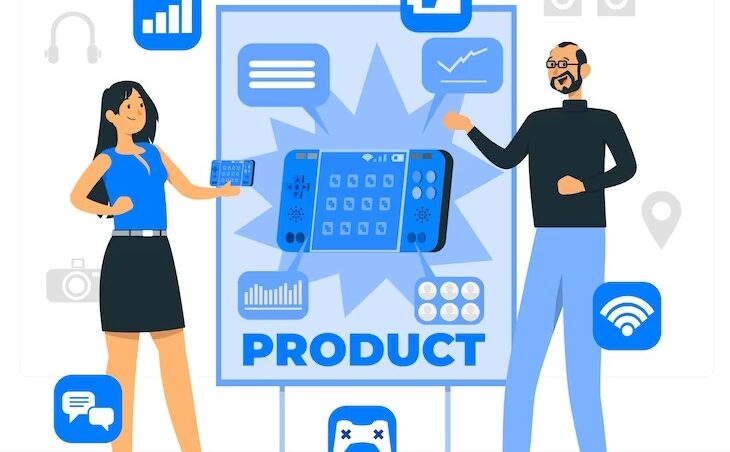
In today’s competitive business landscape, effective product marketing is the key to success. Whether you are launching a new product or looking to revamp your existing marketing strategies, a well-thought-out plan can make all the difference. Let’s dive into the essential steps to on how to market a product successfully.
How to Market a Product – Step by Step Procedure
I. Introduction on How to Market a Products
A. Definition of Product Marketing
Product marketing is more than just promoting a product; it involves understanding the market, identifying the target audience, and crafting compelling strategies to drive sales.
B. Importance of Effective Product Marketing
A well-executed product marketing plan not only increases sales but also builds brand awareness and customer loyalty.
II. Understanding Your Audience
A. Identifying Target Demographics
Knowing your audience is crucial. Conduct thorough research to identify the demographics that align with your product.
B. Analyzing Consumer Behavior
Understanding how your target audience makes purchasing decisions helps tailor your marketing approach.
III. Market Research
A. Competitor Analysis
Study competitors to identify strengths, weaknesses, opportunities, and threats.
B. SWOT Analysis for Your Product
Conduct a SWOT analysis to understand your product’s strengths, weaknesses, opportunities, and threats in the market.
IV. Developing a Unique Value Proposition
A. Defining Your Product’s USP
Clearly articulate your product’s unique selling proposition to stand out in the market.
B. Crafting Compelling Messaging
Create persuasive and customer-centric messaging that resonates with your target audience.
V. Choosing the Right Marketing Channels
A. Digital Marketing Strategies
Leverage digital channels like social media, email, and online advertising for wider reach.
B. Traditional Marketing Methods
Explore traditional methods such as print ads, TV, and radio for a comprehensive marketing strategy.
VI. Building an Online Presence
A. Website Optimization
Ensure your website is user-friendly, visually appealing, and optimized for search engines.
B. Social Media Engagement
Actively engage with your audience on social media platforms to build a community around your brand.
VII. Utilizing Content Marketing
A. Creating Relevant and Valuable Content
Develop content that educates, entertains, and provides value to your audience.
B. Implementing SEO Strategies
Optimize your content for search engines to improve visibility and organic reach.
VIII. Launching Effective Campaigns
A. Planning and Execution
Carefully plan and execute marketing campaigns to create a buzz around your product.
B. Monitoring and Adjusting
Regularly monitor campaign performance and make adjustments based on real-time data.
IX. Influencer Marketing
A. Identifying Suitable Influencers
Collaborate with influencers whose audience aligns with your target market.
B. Building Mutually Beneficial Partnerships
Establish long-term relationships with influencers to enhance credibility and reach.
X. Customer Feedback and Adaptation
A. Gathering and Analyzing Feedback
Actively seek feedback from customers and use it to improve your product and marketing strategies.
B. Adapting Strategies Based on Customer Insights
Be flexible and willing to adapt your marketing strategies based on customer preferences and market trends.
XI. Measuring Success
A. Key Performance Indicators (KPIs)
Define and track key performance indicators to measure the success of your marketing efforts.
B. Analyzing ROI
Evaluate the return on investment to ensure your marketing strategies are cost-effective.
XII. Overcoming Challenges
A. Common Pitfalls in Product Marketing
Be aware of common challenges and pitfalls in product marketing to avoid them.
B. Strategies for Overcoming Challenges
Develop contingency plans and strategies to overcome unforeseen challenges.
XIII. Future Trends in Product Marketing
A. Emerging Technologies
Stay abreast of technological advancements that could shape the future of product marketing.
B. Shifting Consumer Preferences
Adapt your strategies to align with evolving consumer preferences and behaviors.
XIV. Case Studies
A. Successful Product Marketing Campaigns
Explore case studies of successful product marketing campaigns for inspiration.
B. Lessons Learned from Failures
Analyze failures to learn valuable lessons that can inform future marketing strategies.
XV. Conclusion
In conclusion, effective product marketing requires a comprehensive approach that encompasses audience understanding, strategic planning, and continuous adaptation. By following these steps, businesses can create impactful marketing campaigns that resonate with their target audience and drive success.
LIKE WHAT YOU’RE READING?
CHECK OUT SOME OF OUR OTHER GREAT CONTENT HERE:
- DEFINITION OF MARKETING MANAGEMENT
- DECODING DIRECT MARKETING WITH EXAMPLES
- MARKETING MANAGER ROLES AND RESPONSIBILITIES
- ROLE OF BLOGS IN MARKETING
- WHAT IS AFFILIATE MARKETING? (HOW TO GET STARTED)
- PERFORMANCE MARKETING – A BEGINNER’S GUIDE
- EFFECTIVE BRANDING METHODS
- UNDERSTANDING CONSUMER BEHAVIOR
- HOW TO INCREASE SALES?
- HOW AI IS USED IN DIGITAL MARKETING?
- 5 BEST SOCIAL MEDIA PLATFORMS FOR BUSINESS IN 2022
- WHAT IS THE DEFINITION OF ECOMMERCE
- ROLE OF SOCIAL MEDIA IN MARKETING
- WHAT IS ZERO-BASED BUDGETING
- 5 BEST TOOLS FOR DIRECT MARKETING WITH ADVANTAGES IN DETAIL
- 5 BEST MARKETING STRATEGY IN PRODUCT LIFE CYCLE FOR 2023
- 8 STRATEGIES OF RETAIL MARKETING TO DRIVE SALES
- WHAT IS THE IMPORTANCE OF MARKETING IN A BUSINESS?
- DEFINITION OF B2C MARKETING WITH EXAMPLE
- THE ROLE OF MARKETING IN STRATEGIC PLANNING
- WHAT IS A MARKETING RESEARCH?



